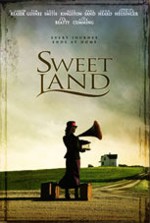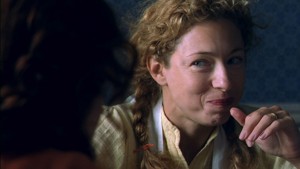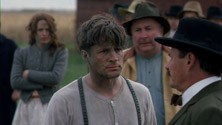
Return to 2006 Films
Alphabetic
Index of 2006
Films
_______________
An Inconvenient Truth
Big Bad Swim
Brokeback Mountain
Capote
Cinderella Man
Crash
The Departed
The DaVinci Code
Eron: The Smartest
Guys in the Room
Good Night and
Good Luck
Half Nelson
History of Violence
Hollywoodland
Hotel Rwanda
Little Miss Sunshine
Journey from the Fall
March of the Penguins
Millons
Million Dollar Baby
Munich
Prairie Home Companion
Prime
Quinceanera
Sideways
Star Wars III:
Revenge of the Sith
Thank You for Smoking
The Three Burials of Melquiades Estrada
The Sea Inside
United 93
War of the Worlds
Walk the Line
World Trade Center
|
Film Synopsis Sweet Land is a stunning film. Set in rural Minnesota, the film opens in the not-too-distant past, with the death of Olaf, an aged farmer of Norwegian descent. We meet Inge, Olaf’s wife, along with family members and family friend Frandsen, at the wake in their own farm house. Inge finds a box of old photographs, including one of herself taken in 1920, newly arrived in this country. The movie then takes us back to Inge’s arrival as a very young mail order bride, many decades ago. We see Inge nervously waiting for Olaf at the train station with two suitcases and a large Victrola phonograph. Olaf and Frandsen arrive and immediately take Inge to the Lutheran church for the wedding. However, Inge informs them that she is German, not Norwegian. Olaf, Frandsen, and the pastor are speechless. The memory of World War I was still fresh and Anti-German sentiment was strong. The pastor refuses to perform the marriage ceremony, saying the Inge does not have the correct “papers.” He suggests that they go to the county judge; maybe he can help them. Inge, in her very broken English, protests that “Luther was German!” However, the pastor remains firm. The judge also refuses to marry Inge and Olaf, wondering if she may be a spy. “I thought we won the war,” Olaf mutters to himself.
Working from the short story, “A Gravestone Made of Wheat” by Will Weaver, writer-director Ali Selim, lovingly brings the story of Inge and Olaf to life. Selim treats the characters and their dilemmas with deep respect, as well as a sense of humor. There is a deep sense of culture of rural Minnesota culture: hard working, faithful, reserved Norwegian Lutherans, respecting God, the land, family, and community. After two hours, I really felt like I knew Olaf, Inge, and their community. Visually, Sweet Land is stunning. Every detail richly evokes
the period. The cinematography captures the wide expanse of the
rural landscape and the vastness of the Midwestern sky. Much of
the drama is expressed in the visual images. In a lovely sequence,
Inge and Olaf walk side-by-side through the field. First their
hands brush against each other, then, naturally, gently, silently,
Olaf’s hand holds Inge’s. The many night scenes are
beautiful, including one in which Inge sees the Northern Lights.
Selim also features such delightful and interesting scenes as
Olaf taking a photographof the newly-arrived Inge (the same photo
Inge finds at Olaf’s wake), and an early motion picture
of Eskimos kissing, projected in Frandsen’s barn. A crisis arises late in the film that becomes a defining moment for Olaf, as well as the community. (Since I do not want to spoil the enjoyment of the movie, I will not go into detail.) Olaf responds in a way that puts him at great risk. The scene captures the moral character of Olaf: a spontaneous action done purely out of loving concern for another. It is an astonishing moment, full of grace. The courageous act of Olaf changes the hearts of others in the community. It’s a moment of congregational redemption. So often in films we witness the effect of violence on individuals, families, communities. It’s nice for a change to have the opportunity to witness the effects of a courageous, loving act on others.
Not the least of Sweet Land’s accomplishments is the way in which this period film can shed light on contemporary issues. The most obvious is the attitude toward immigration. Love eventually wins out in the film. Let’s pray that love leads to justice for the immigrant in our own time as well. Sweet Land is scheduled for release in selected cities in October. I hope it gets the wide release it deserves. I loved this movie and highly recommend it to everyone. Tom Condon, OP
|
Not Rated |
 Home | Contact Us | DLC Dominican Life | USA is sponsored by the Dominican Leadership Conference, the networking organization for elected leaders in the USA. Dominican Life | USA © 2002-2007, All Rights Reserved Web Editor: Anne Lythgoe, OP |
|---|



 Olaf
and Frandsen wonder what they will do about this awkward situation.
It was simply out of the question for Olaf to take Inge into his
house without being legally married. Frandsen offers to take her
in to his house, along with his wife and nine children. Frandsen’s
family is welcoming, but there is little room for Inge. In addition,
the bank is threatening to foreclose on Frandsen’s farm
unless back mortgage payments are made. One night, Inge sneaks
out and returns to Olaf’s house. Still determined to “do
the right thing,” the couple decide that Inge will sleep
in the bedroom and Olaf in the barn until they are able to marry.
Despite the many obstacles to be negotiated, Inge and Olaf grow
in their respect and affection for each other until they fall
deeply in love.
Olaf
and Frandsen wonder what they will do about this awkward situation.
It was simply out of the question for Olaf to take Inge into his
house without being legally married. Frandsen offers to take her
in to his house, along with his wife and nine children. Frandsen’s
family is welcoming, but there is little room for Inge. In addition,
the bank is threatening to foreclose on Frandsen’s farm
unless back mortgage payments are made. One night, Inge sneaks
out and returns to Olaf’s house. Still determined to “do
the right thing,” the couple decide that Inge will sleep
in the bedroom and Olaf in the barn until they are able to marry.
Despite the many obstacles to be negotiated, Inge and Olaf grow
in their respect and affection for each other until they fall
deeply in love. Sweet
Land is wonderfully acted. Elizabeth Reaser and Tim Guinee are
Inge are excellent as Inge and Olaf. The supporting cast includes
many fine actors who you will certainly recognize, even if they
are not exactly household names: Alan Cumming, Alex Kingston,
John Heard, Ned Beatty and Lois Smith.
Sweet
Land is wonderfully acted. Elizabeth Reaser and Tim Guinee are
Inge are excellent as Inge and Olaf. The supporting cast includes
many fine actors who you will certainly recognize, even if they
are not exactly household names: Alan Cumming, Alex Kingston,
John Heard, Ned Beatty and Lois Smith. Also
Known As: The Wedding Photo
Also
Known As: The Wedding Photo